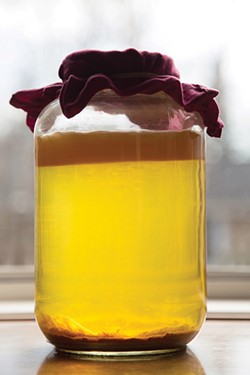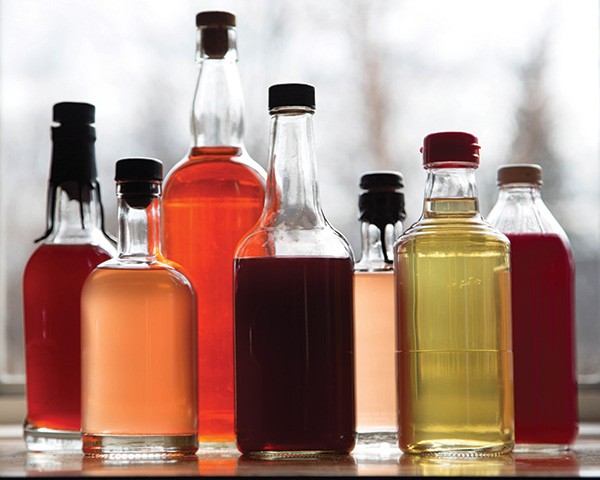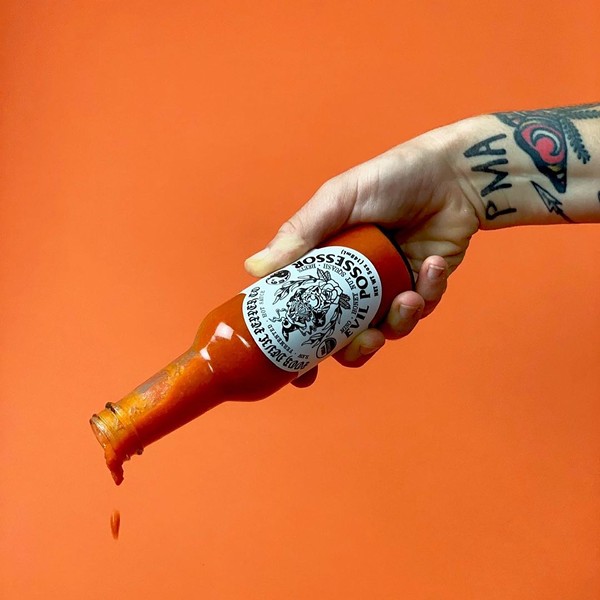A few years ago, I profiled Brother Victor-Antoine d'Avila-Latourrette, a Benedictine monk who makes the best vinegars I've ever tasted. Pursuant to that visit, and several others since, I have become somewhat of a vinegar-making addict; my kitchen counter currently boasts 10 half-gallon jars with various versions in different states of ferment. Vinegar is hands down the easiest of all homemade products, and though it takes a while—six to 12 months if you do it right—the results will excite and enliven your cooking practice as much as anything else you make. To wit: Virtually all of the standard condiments (ketchup, mustard, mayonnaise, barbecue sauce) that you currently pay for can be made better at home, and having custom vinegars on hand is a key first step.

Not Far From the Tree
We live in one of the world's great apple regions. To not take advantage, specifically in the form of homemade cider vinegar, is an affront to your geographical privilege. Apple juice, left to its own devices, becomes vinegar. Yeast and acetic acid bacteria are omnipresent; they're all over your kitchen right now. All you have to do is let them do their thing. Their thing, it turns out, is a nifty one-two punch that makes sweet juice into sour vinegar: Yeast ferments the sugar into alcohol, and then acetobacteria ferment that into vinegar. If you can get unpasteurized cider, pour it into a glass jar (cover it with cheesecloth to keep the flies out) and leave it somewhere at room temperature for six months. If you can't get unpasteurized juice, be sure to add a generous glug of the raw cider vinegar "with the mother," available at health food stores.
Every fall, I pick sumac panicles and blend them with cider, letting them steep overnight, then strain the result and inoculate it with mother; the result is beautiful pink liquid that has lovely blood orange-type flavors. I also use black currant juice from Connecticut to make brilliant violet vinegar that's pure joy and very drinkable on its own (diluted, of course). Wine—red and white—also ferments alongside jars of spruce tips that I pick in May, steep in vodka, then dilute with white wine and inoculate with mother. All of these make for glorious and very local substitutes for citrus in cooking and even cocktails. It's worth remembering that kombucha and vinegar are two points on the same continuum of fermentation; if you make your own kombucha and let it sit a few months longer, you've got vinegar. And once you've got vinegar, you hold the key to condiment independence.
Mayo Clinic
Many people are intimidated by the thought of making mayonnaise. I understand; if done improperly, it can break, and that only needs to happen once in order for the shame of failure to attend any subsequent urges in that direction. Most mayonnaises break because there's not enough water for the egg yolk to form a stable emulsion with the copious oil you're pouring in. I usually use vinegar; lemon is obviously a popular choice, but it's not a local flavor. If you want an extra-mild version, use a couple tablespoons of water, but acidity makes it better, and safer (given the raw egg yolk). Whatever the form, that extra splash of moisture means that all those fat molecules you're about to add have enough dance partners to emulsify and thicken your mayo to a redoubtable stiffness. Besides vinegar, pickle brines or hot sauces can also be used to great effect.
Mustard contains lecithin, a powerful emulsifier, so a teaspoon or so helps a lot. Garlic is always good, and also helps emulsify; roasted garlic is magnificent, as are fresh herbs. I use the food processor, but a blender works, if noisily, and you can whisk by hand as well. Add the oil in a spaghetti-thin stream, especially at the outset. I like olive oil; it's good for you and has a wonderful flavor. Shitty oil makes shitty mayonnaise. A cup of oil per yolk is a good ratio. Depending on its intended use, it's fun to tweak your oil mixture a bit: a bit of sesame, or mustard, or walnut, or pumpkin seed oil can tilt the flavor any which way. Mixtures are nice: A base of olive, for example, with some rendered bacon fat mixed in is not the worst combination in the world.
I put an egg yolk, a spoon of mustard, a glug of vinegar, a fat pinch of salt, and a twist of pepper in the bowl of the food processor, along with any other custom flavorings like preserved lemon, grated garlic, herbs, spices, hot peppers, or the like. The key is in that vinegar or citrus juice. If you're nervous, add a tablespoon or two more of water to be sure. Measure out a cup of oil(s) into a pitcher with a spout. Then start the motor, dribbling the oil in super gently—spaghetti-thin, remember—until you see the viscosity change and thicken. The liquid will become more of a goop, and begin lapping at the sides of the vessel. At this point you can increase the flow rate of the oil if you like. Once the oil is gone, stop the blade, open it up, and spatulate the mayo thoroughly to get at the layer of oil that will be hiding under your blade. Then pulse it a few more times to fully incorporate it. And you're done. Be happy; you just mastered one of the most vivid examples of how much better homemade food is than store bought. Now every manner of dip, tartar sauce, Russian dressing, and glorious sandwich is within your reach.














